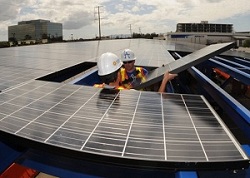Week in review: Giant solar projects start to come online
 The solar industry made some impressive gains recently, with what’s now the world’s largest operational photovoltaic array coming online in California. Meanwhile the SolarStrong project moved forward with it efforts to solarize military housing across the country and California announced that it’s distributed generation resources on homes and businesses has exceeded 1 gigawatt. That being said, the industry still faces challenges. For instance, Colorado’s largest utility was approved to steeply reduce its solar incentives and materials costs for PV still remain a barrier to cheaper PV.
The solar industry made some impressive gains recently, with what’s now the world’s largest operational photovoltaic array coming online in California. Meanwhile the SolarStrong project moved forward with it efforts to solarize military housing across the country and California announced that it’s distributed generation resources on homes and businesses has exceeded 1 gigawatt. That being said, the industry still faces challenges. For instance, Colorado’s largest utility was approved to steeply reduce its solar incentives and materials costs for PV still remain a barrier to cheaper PV.
Last week, at 200 megawatts of AC installed and operational photovoltaics Agua Caliente became the largest operational photovoltaic farm in the world. It’s the first time in a number of years that the U.S. has had the largest plant. And it’s not completed yet. The 290 MW project is being developed by First Solar for project owners MidAmerican Energy Holdings and NRG Energy. It was under contract to start providing the 200 MWs to Pacific Gas & Electric (PG&E) this year and will start providing the rest in 2014.
One of the nation’s largest distributed generation projects, SolarStrong, also made a big move forward last week when SolarCity announced that it was furthering its partnership with Australlian-based Lend Lease, which owns military housing across the U.S. Under the expanded partnership, SolarCity will install photovoltaic arrays on 850 military residences at Tierra Vista at the Los Angeles Air Force Base, and at Peterson AFB and Schriever AFB, both in Colorado Springs, Colo. In all, it’s a $1 billion project financed through U.S. Renewables Group Renewable Finance and Bank of America Merrill Lynch.
California reported recently that among the other large solar projects being built in the state, it’s also growing the number of small distributed projects throughout the state. In the California Public Utilities Commission’s (CPUC’s) 2012 California Solar Initiative (CSI) Annual Program Assessment the state revealed that by the first quarter of 2012, 1.26 gigawatts of photovoltaics were installed at 122,516 sites across the state.
In news that’s less sunny for the solar sector, Colorado’s largest utility, Xcel Energy’s Public Service Company of Colorado, was allowed to significantly reduce its incentives for solar. In a move that surprised the national Solar Energy Industries Association (SEIA) and the Colorado chapter, COSEIA the Colorado Public Utilities Commission decided to dismiss an appeal by the associations that asked the commission to its ruling. Under the new incentive program Xcel no longer offers homeowners up front rebates for purchasing solar. Previously it offered a rebate of $2.01 per watt in addition to a net-metering rate. Now it offers homeowners installing net-metered solar systems a rebate of 15 cents per kilowatt hour produced by the system.
The manufacturing side of solar continues to face its own issues. Chief among them is oversupply, which has forced companies to drop prices and has led to multiple companies filing for bankruptcy. At the same time incentives that have made solar more attractive are falling. Still, there are ways that companies will benefit from all the changes and issues. Germany Trade and Invest likens this period to the period when personal computers became affordable and contended that it’s actually a positive for the industry.
Meanwhile the costs of silver, an important conductive material in a lot of PV cells, is going up, forcing manufacturers already competing to produce the cheapest, high-quality PV cells to look for more innovation to keep materials costs down. A new Lux Research report observed that the cost of silver has seen a six-fold price increase since 2002. Those rising costs have spurred manufacturers to look to other conductive materials to use in PV cells. Among the prime alternatives are copper pastes, nickel phosphide and printing techniques that can reduce the materials needed in the cell.



